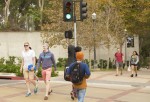Fall quarter brings students back to the Hill, where they keep the crosswalk between De Neve and Bruin Walk busy. Students who are in a hurry to get to class may cross without waiting for the green walk signal. Daily Bruin Radio investigates the trends of ticketing on the crosswalk and how it affects students.
—
TRANSCRIPT:
NANAYAKKARA: Pedestrians shuffle by while skateboarders whiz past the crosswalk between De Neve Plaza and Bruin Walk. For those on foot, the temptation to cross while the light is red is great. However …
FINCH: Even if it’s counting down and the light’s still green for you, you’re not supposed to start.
NANAYAKKARA: That was Lee Finch, an officer from the UCPD.
FINCH: It’s not actually considered jaywalking. It’s a special section when you cross on a red light or a red hand. Jaywalking is when you cross on the middle of the block somewhere that’s controlled by traffic light on each side.
NANAYAKKARA: Benjamin Morris, a fourth-year civil engineering student and resident assistant, has lived on the Hill since his freshman year. He understands why the university might not want students committing a crossing violation.
MORRIS: The university wants to avoid any sort of injury to students and try to make sure the traffic flow is as good as possible over there.
FINCH: What we are concerned about is maybe they didn’t see the car, and then everybody starts following behind him and you have this chain of students coming. Now a car really is coming, and those people are endangered.
NANAYAKKARA: Again, that was Finch, who – like Morris – cites safety as a key reason for legal crossing of the street. The UCPD tends to patrol the area more during the beginning of the school year in order tolet students know not to illegally cross between De Neve Plaza and Bruin Walk.
FINCH: We do like to start off with a new batch of students to try to let people know – let the students know – that this is an area that we do enforce. Most officers, the first week or two, will give verbal warnings, and then obviously eventually we have to start issuing citations to get more compliance.
NANAYAKKARA: Morris describes other ways that have caused an increase in awareness about the legal way to cross.
MORRIS: They’ve had more signage up. They’ve gotten more of a presence out there trying to deter jaywalking.
NANAYAKKARA: But the greatest deterrence of all may be a ticket.
FINCH: You know the thing about writing one ticket is that person’s going to tell somebody, and they’re going to tell somebody, and so on. And we have learned that writing a few tickets will decrease the number of people committing the violation.
NANAYAKKARA: While he says officers start with verbal warnings, Finch also estimates that 30 to 40 tickets have been given at the crosswalk since the beginning of the school year. These tickets are not cheap.
FINCH: There’s no cheap ticket in California, I can guarantee you that. My guess is it’s anywhere from 175 to 225.
NANAYAKKARA: Whether or not you should shave off a couple extra seconds from your morning walk may not be such a tough question after all. With prices like those, it may seem that the easier choice is to wait for the green walk signal.
For Daily Bruin Radio, I’m Priyanka Nanayakkara.
